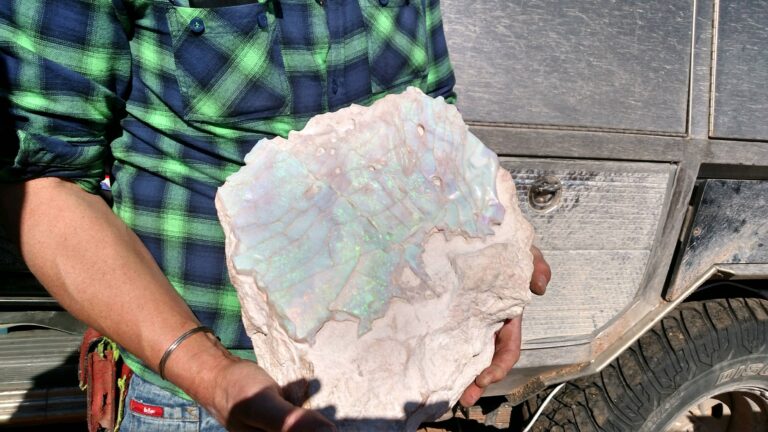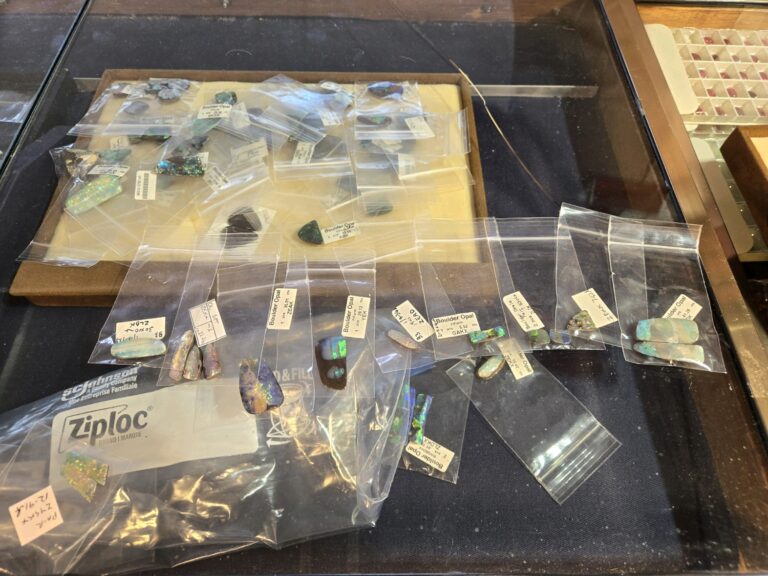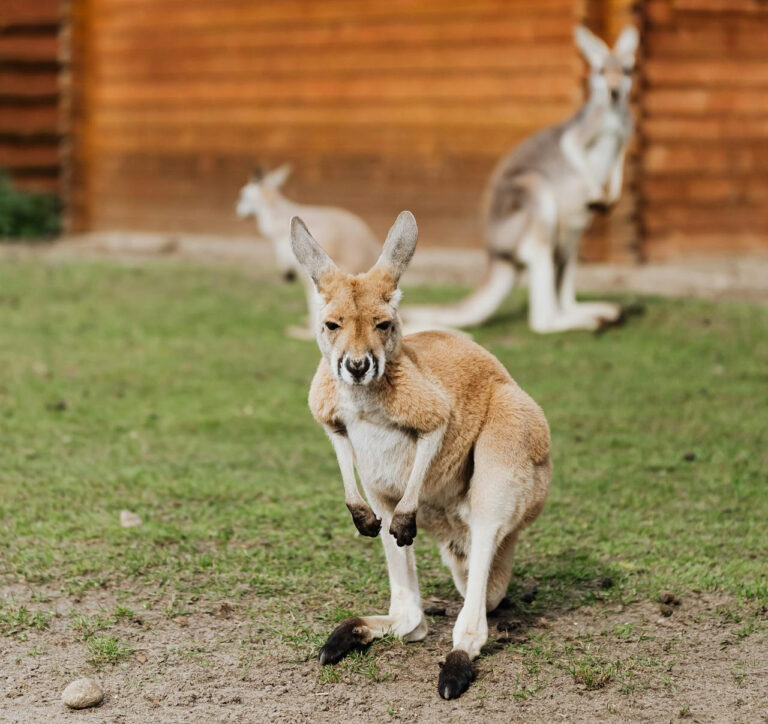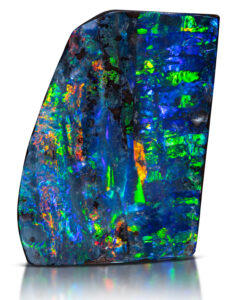By Jennifer Heebner, Editor in Chief
Michael Traurig has been winding down his business for several years, getting ready to retire after more than four decades selling Australian Opals. Traurig is the last employee of Jayson Traurig Bros. of Australia, a business started by his father, John, and uncle, Tom, in Sydney in the late 1950s.
Traurig’s last AGTA GemFair Tucson was earlier this year, leaving him to reflect on a lifetime of sourcing, buying, selling, and cutting all the varieties of beautiful Australian Opal. Below, he shares some memories and brings us up to speed on how his niche has changed.
This conversation has been edited for space and clarity.

Michael Traurig on His Early Days
“I dropped out of high school six weeks before graduation. Turns out I had dyslexia, and nobody understood—including me. Still, I got a good job at a bank in Australia until my father and uncle made me an offer I couldn’t refuse. I started working with them in 1981 in the eastern suburb of Sydney.
“They had a shirt factory and a casting company that made base metal cufflinks to go with the shirts—so, no Opal at all. But one of their casters brought in a box of rough Opal one day (he sold some on the side). He asked them if they would be interested in buying it and trying to sell it. So they took half the lot and sold it fairly quickly, going back for the other half and selling that, too, making a profit on both.
“Their big break came from Rupert Murdoch, who owned the Daily Mirror. Murdoch hired them to make some commemorative faux coins for some promotional release that took place in The Rocks, a tourist area of Sydney. After the event ended, Murdoch said to them, ‘You sell Opals, too, don’t you? Fill this space with Opals and I’ll get the TV stations to come back tomorrow to do a story on you.’
“Since they were new to the Opal business, my father and uncle reached out to a dealer friend of theirs, the biggest Opal dealer in Australia at the time—Greg Sherman of Sherman Opals—for help filling the space. Sherman was a good man and filled that space for them with Opal, giving them a bit of a start in the business.
“My dad was also selling some other types of gems—Chrysoprase and Tiger’s Eye—for a big mining company and was sent to America to sell more. He was allowed to bring some Opal with him. He took them to Eddie Kalfayan in Los Angeles, walking in with an entire briefcase full of Opal. Eddie asked to buy the whole case, and my dad said, ‘Eddie, I can’t sell you the whole case because then I’ll have to go home, and I haven’t yet had a chance to look around this country yet.’ That started their friendship.”

Traurig Hits the Road
“When I started with Opals in 1981, there was a lot more mining going on. In Coober Pedy in the south, there were about 3,000 mining operations. In Lightning Ridge in New South Wales, there were about 1,000 mining concessions. And in Quilpie in the Boulder Opal fields in Queensland, there were about 1,000.
“I would drive from Sydney to Coober Pedy with a colleague named Louis Kennedy in a panel van. It was about 2,500 miles each way, and we would take turns driving so we didn’t have to stop. At some point, Kennedy spent a half an hour trying to teach me to cut Opal. I didn’t have the patience for it! So, he told me to learn to buy and sell well, because I wouldn’t be a cutter.
“My first trip to America was in 1982—the year of the first American Gem Trade Association (AGTA) fair in Tucson. That trip got me started spending six weeks at a time in the U.S., traveling to shows and dealers to sell. I did some InterGem Jewelry Shows, Jewelers of America shows, and every edition of the AGTA GemFair Tucson up to this year.
“My cousin Robert joined the business, too, in the 1980s, working the Tucson shows with me. He stayed with us until 2007, when the financial crisis hit America. This caused the whole world to nearly collapse! Business was tight for a while, so he went back to work for a bank in Australia.
“A client in Dallas in 1985 led me to have my biggest sale to date. To celebrate, I went to a Chili’s restaurant for dinner, meeting my first wife. We closed the place down that night! But the next day I was off to Chicago, and then to New York and Boston. At the end of my East Coast travels, I arranged to meet her again in Dallas. We decided pretty quickly to get married. I flew home shortly after and told my father and uncle what I did, and that I would be moving to America.”



The Opal Business Evolves
“Into the 1990s, there was a big find of Opal in Lightning Ridge, and there were more miners than ever—as many as 3,000 concessions. People like me, my dad, and my uncle bought and cut as much material as we could. The material was amazing! And there was enough to go around. There was so much excitement, but it died off after about 10 years. Now there are more like 50 establishments mining Opal in Lightning Ridge.
“Before the world opened up, we used to do huge numbers. We bought from the miners and probably paid more than we could have, but we wanted them to make money, too. That’s one thing I learned from my dad and uncle was to always treat people right and do the right thing.
“Then people learned about the source and started going to it. When there was no Internet or people going to the mines, there was no knowledge of the places where material came from, not like now. I could just show up at a little trade shop on South Hill Street in Los Angeles or on 47th Street in New York and sell to the wholesale trade. More people were making money, and the trade was happy to not have to do all that work of getting the Opal. There was no travel like there is now.
“Fifteen years ago was when I first noticed the changes. I went from Phoenix to an Opal fair in Australia and who did I see but some customers from Hawaii and Los Angeles. They asked me, ‘What are you doing here?’ and I asked them the same thing! I told them, ‘You’re trying to do the run around me, aren’t you?’ And eventually the miners made a run around their client base because they felt the trade wasn’t buying enough. Now everyone knows where to get the material.
“As my partners in Australia wound things down, I couldn’t see the material that I would reject as quickly—you need someone on the ground in Australia to do that. Eventually, I stopped any other shows besides AGTA GemFair Tucson; besides, clients to those other shows stopped going. I’ve had dinner at Li’l Abner’s Steakhouse every year since 1983! I met Connie, one of the owners there now, when she was just 15!
“Now I’m selling off my inventory and living not far from Tucson—I can drive down there for dinner when I want to! And when people ask me what I’ll do next year during the Tucson show, I say you’ll see me sitting on that red bench next to my old booth, watching the new tenant. I know it won’t feel quite right, but I’ll still be there. And I won’t miss packing up on the last day.”
This is proprietary content for AGTA and may not be reproduced.
